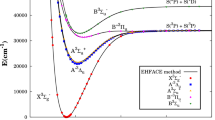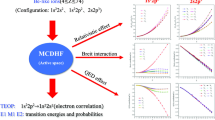Abstract
The electronic and rovibrational structure of (1A1) NaH2 + has been investigated using a relativistically-corrected, all-electron coupled-cluster with singles, doubles and perturbative triples (CCSD(T)) ansatz. For the electronic ground state this ansatz yielded equilibrium Na–H bond lengths (R e ) of 2.4208 Å and an equilibrium H–Na–H bond angle (θe) of 17.8°. An analytical potential energy surface (PES) was embedded in the rovibrational Hamiltonian. The PES was constructed using 118 CCSD(T) points and exhibited a residual error of 1.2 cm−1. The rovibrational Hamiltonian was diagonalised using variational techniques. The vibrational and rovibrational eigenvectors were assigned using a configuration weight scheme in terms of normal modes and the Mulliken assignment scheme, respectively. For the ground vibrational state of (1A1) NaH2 +, the vibration-averaged bond lengths 〈R〉 and angle 〈θ〉 were 2.4995 Å and 17.1°, respectively. The ab initio (1A1) NaH2 + PES yielded a dissociation energy (D 0) value of 10.3 kJ mol−1, which is in excellent agreement with the experimental value of 10.3 ± 0.8 kJ mol−1 (Bushnell et al. in J Phys Chem 98:2044, 1994). An analytical dipole moment surface was constructed using 90 CCSD(T) points. Rovibrational spectra of (1A1) NaH2 +, (1A′) NaHD+ and (1A1) NaD2 + for v ≤ 10, J ≤ 5 were constructed using rovibrational transition moment matrix elements calculated in a novel manner that employs the analytical dipole moment surface (DMS). The rovibrational structure of the Na+–H2 v HH = 1 ← v HH = 0 band was calculated and compared to that of Li+–H2.



Similar content being viewed by others
References
Gianturco FA, Giorgi PG, Berriche H, Gadea FX (1996) Astron Astrophys Supp Ser 117:377
Sanz C, Bodo E, Gianturco FA (2005) Chem Phys 314:135
Page AJ, von Nagy-Felsobuki EI (2008) J Mol Struct (Theochem) 853:53
Burrows A, Volobuyev M (2003) Astrophys J 583:985
Page AJ, von Nagy-Felsobuki EI (2007) J Phys Chem A 111:4478
Kraemer WP, Spirko V (2006) Chem Phys 330:190
Emmeluth C, Poad BLJ, Thompson CD, Weddle GH, Bieske EJ (2007) J Chem Phys 126:204309
Thompson CD, Emmeluth C, Poad BLJ, Weddle GH, Bieske EJ (2006) J Chem Phys 125:044310
Papousek D, Aliev M (1982) Molecular vibration-rotation spectra. Elsevier, Prague
Switalski JD, Huang JTJ, Schwartz ME (1974) J Chem Phys 60:2252
Falcetta MF, Pazun JL, Dorko MJ, Kitchen D, Siska PE (1993) J Phys Chem 97:1011
Curtiss LA, Pople JA (1988) J Phys Chem 92:894
Bushnell JE, Kemper PR, Bowers MT (1994) J Phys Chem 98:2044
Tamassy-Lentei I, Szaniszlo J (2000) J Mol Struct (Theochem) 501:403
Barbatti M, Jalbert G, Nascimento MAC (2001) J Chem Phys 114:2213
Vitillo JG, Damin A, Zecchina A, Ricchiardi G (2005) J Chem Phys 122:114311
Page AJ, von Nagy-Felsobuki EI (2008) Chem Phys 351:37
Page AJ, von Nagy-Felsobuki EI (2007) Mol Phys 105:2527
Roos BO, Veryazov V, Widmark P (2004) Theor Chem Acc 111:345
Woon DE, Dunning TH (1994) J Chem Phys 100:2975
Dunning TH (1989) J Chem Phys 90:1007
Douglas M, Kroll NM (1974) Ann Phys (NY) 82:89
Hess BA (1986) Phys Rev A 33:3742
Wells B, Wilson S (1983) Chem Phys Lett 101:429
Werner H-J, Knowles PJ, Lindh R, Manby FR, Schütz M, Celani P, Korona T, Rauhut G, Amos RD, Bernhardsson A, et al (2006) MOLPRO, v. 2006.1, a package of ab initio programs. http://www.molpro.net
Carney GD, Langhoff SR, Curtiss LA (1977) J Chem Phys 66:3724
Harris DO, Engerholm GG, Gwinn WD (1965) J Chem Phys 43:1515
Watson JKG (1968) Mol Phys 15:479
Burton PG, von Nagy-Felsobuki E, Doherty G, Hamilton M (1984) Chem Phys 83:83
Searles DJ, von Nagy-Felsobuki EI (1988) Am J Phys 56:444
Strang G, Fix GJ (1973) An analysis of the finite element method. Prentice-Hall, New-Jersey
Searles DJ, von Nagy-Felsobuki EI (1991) J Chem Phys 95:1107
Sudarko, Hughes JM, von Nagy-Felsobuki EI (2000) Aust J Phys 53:665
Zare RN (1987) Angular momentum. Wiley, New York
Dixon DA, Gole JL, Komornicki A (1988) J Phys Chem 92:1378
Searles DJ, von Nagy-Felsobuki EI (1991) Phys Rev A 43:3365
Searles DJ, von Nagy-Felsobuki EI (1991) In vibrational spectra and structure. Elsevier, New York
Searles DJ, von Nagy-Felsobuki EI (1992) Comp Phys Commun 67:527
Searles DJ, von Nagy-Felsobuki EI (1991) Ab initio calculations of vibrational band origins. Elsevier, New York
Jordan KD, Kinsey JL, Silbey R (1974) J Chem Phys 61:911
Jorish VS, Scherbak NB (1979) Chem Phys Lett 67:160
Pardo A, Camacho JJ, Poyato JML (1986) Chem Phys Lett 131:490
Ogilvie JF (1981) Proc Roy Soc London Ser A A378:387
Forsythe GE, Malcolm MA, Moler CB (1977) Computer Methods for Mathematical Computations. Prentice-Hall, New York
Gabriel W, Reinsch E-A, Rosmus P, Carter S, Handy NC (1993) J Chem Phys 99:897
Fink U, Wiggins T, Rank D (1965) J Mol Spec 18:384
Wolniewicz L (1966) J Chem Phys 45:515
Acknowledgments
The authors wish to acknowledge support from the Australian Partnership for Advanced Computing (APAC), the Australian Centre for Advanced Computing and Communications (AC3) and the high-performance computing facility of The University of Newcastle, Australia. A.J.P. wishes to acknowledge support from the Australian postgraduate award scheme.
Author information
Authors and Affiliations
Corresponding author
Rights and permissions
About this article
Cite this article
Page, A.J., von Nagy-Felsobuki, E.I. Ab Initio rovibrational spectrum of the NaH2 + ion–quadrupole complex. Theor Chem Account 122, 87–100 (2009). https://doi.org/10.1007/s00214-008-0487-7
Received:
Accepted:
Published:
Issue Date:
DOI: https://doi.org/10.1007/s00214-008-0487-7




